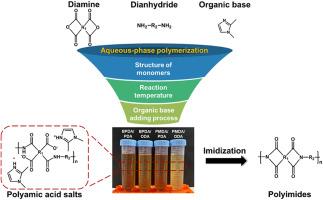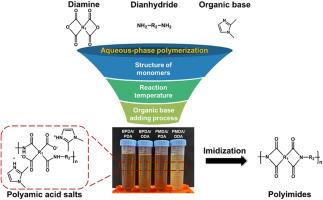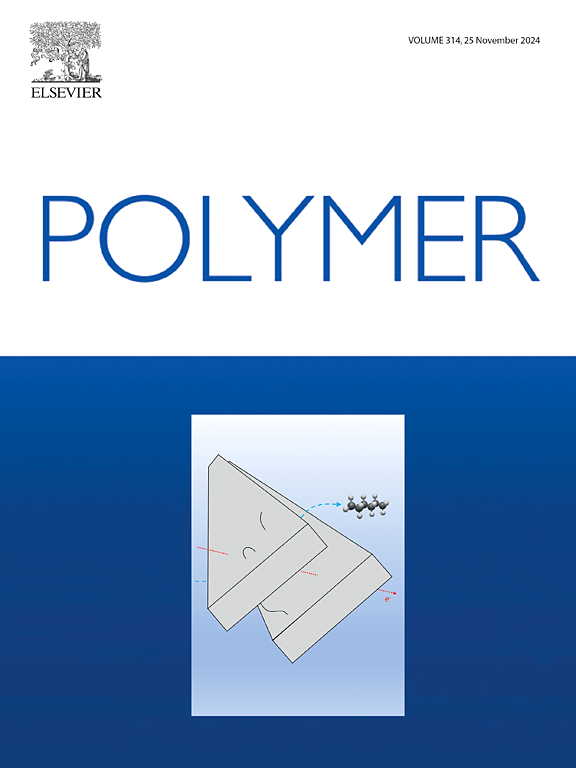One-pot aqueous-phase synthesis of polyimides from typical monomers
IF 4.1
2区 化学
Q2 POLYMER SCIENCE
引用次数: 0
Abstract
One-pot aqueous-phase synthesis of polyimides (PIs) offers great economic and environmental benefits and improves the hydrolytic stability of the precursor (polyamic acid) obviously. However, this method is only suitable for the polymerization of very limited dianhydride and diamine monomers up to now. In this study, the most commonly used dianhydrides and diamines for the preparation of commercially available PI products were selected for one-pot aqueous-phase synthesis of various polyamic acid salts (PAAS). The effects of the structure of monomers, the reaction temperature and the adding process of the organic base on the polymerization reaction were explored by rotational rheology, nuclear magnetic resonance (NMR) and Fourier transform infrared (FTIR) spectroscopy. The polymerization products obtained via the aqueous-phase route show high molecular weight when the reaction conditions have been optimized. Various PI films prepared by the thermal imidization of corresponding PAAS demonstrate good optical transparency, excellent thermal stability, and outstanding mechanical and electrical properties. This work proposes the reaction mechanism of PAAS via one-pot aqueous-phase route and utilizes this novel polymerization strategy to synthesize high-molecular-weight PIs from typical aromatic dianhydride and diamine monomers.


典型单体水相一锅法合成聚酰亚胺
单锅水相合成聚酰亚胺(PIs)具有巨大的经济和环境效益,并明显提高了前体(聚酰胺酸)的水解稳定性。然而,到目前为止,这种方法只适用于非常有限的二酐和二胺单体的聚合。本研究选择了制备市售 PI 产品最常用的二酐和二胺,用于各种聚酰胺盐(PAAS)的水相一锅合成。通过旋转流变学、核磁共振(NMR)和傅立叶变换红外光谱(FTIR),探讨了单体结构、反应温度和有机碱添加过程对聚合反应的影响。在优化反应条件的情况下,通过水相途径获得的聚合产物显示出较高的分子量。通过热亚胺化相应的 PAAS 制备的各种 PI 薄膜具有良好的光学透明性、优异的热稳定性以及出色的机械和电气性能。本研究提出了一锅水相路线 PAAS 的反应机理,并利用这种新型聚合策略从典型的芳香族二酐和二胺单体中合成了高分子量的 PI。
本文章由计算机程序翻译,如有差异,请以英文原文为准。
求助全文
约1分钟内获得全文
求助全文
来源期刊

Polymer
化学-高分子科学
CiteScore
7.90
自引率
8.70%
发文量
959
审稿时长
32 days
期刊介绍:
Polymer is an interdisciplinary journal dedicated to publishing innovative and significant advances in Polymer Physics, Chemistry and Technology. We welcome submissions on polymer hybrids, nanocomposites, characterisation and self-assembly. Polymer also publishes work on the technological application of polymers in energy and optoelectronics.
The main scope is covered but not limited to the following core areas:
Polymer Materials
Nanocomposites and hybrid nanomaterials
Polymer blends, films, fibres, networks and porous materials
Physical Characterization
Characterisation, modelling and simulation* of molecular and materials properties in bulk, solution, and thin films
Polymer Engineering
Advanced multiscale processing methods
Polymer Synthesis, Modification and Self-assembly
Including designer polymer architectures, mechanisms and kinetics, and supramolecular polymerization
Technological Applications
Polymers for energy generation and storage
Polymer membranes for separation technology
Polymers for opto- and microelectronics.
 求助内容:
求助内容: 应助结果提醒方式:
应助结果提醒方式:


